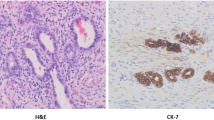Abstract
Fibrous remnants from the porta hepatis and wedge biopsies of the liver were studied in 60 patients with biliary atresia. The patients were divided into three groups on the basis of bile duct diameter — I: no ducts; II: <50 μm; III: >50 μm. The liver damage was classified into three grades on the basis of ductular and parenchymal histopathologic changes and extent of inflammatory pathology. There was no correlation between severity of hepatic damage and duct diameter, although the levels of serum bilirubin and alkaline phosphatase varied in direct proportion to the degree of hepatic damage. There was an inverse relationship between age and duct diameter, but neither correlated with bile flow at surgery or in the postoperative period. The data suggest that Indian children with biliary atresia follow a different clinical course compared to those from Japan and Western countries.
Similar content being viewed by others
References
Altman RP, Chandra R, Lilly JR (1975) Ongoing cirrhosis after successful porticoenterostomy in infants with biliary atresia. J Pediatr Surg 10: 685–691
Bhatnager V, Upadhyaya P, Singh MK, Nayak NC (1984) Clinical features, liver histology and operative success in uncorrectable biliary atresia. Ann Paediatr Surg 1: 92–97
Gautier M, Jehan P, Odievre M (1976) Histologic study of biliary fibrous remnants in 48 cases of extrahepatic biliary atresia: correlation with postoperative bile flow restoration. J Pediatr 89: 704–709
Gupta DK, Upadhyaya P (1982) Biliary atresia: an analysis of 30 cases. Ind J Pediatr 49: 207–214
Hitch DC, Shikes RH, Lilly JR (1979) Determinants of survival after Kasai's operation for biliary atresia using actuarial analysis. J Pedaitr Surg 14: 310–314
Kasai M (1974) Treatment of biliary atresia with special reference to hepatic portoenterostomy and its modifications. Prog Pediatr Surg 6: 5–52
Kasai M, Kimura S, Asakura Y, Susuki H, Taira Y, Ohashi E (1968) Surgical treatment of biliary atresia. J Pedaitr Surg 3: 665
Miyano T, Suruga K, Tsuchiya H, Suda K (1977) A histopathological study of the remnants of the extrahepatic bile ducts in so called uncorrectable biliary atresia. J Pediatr Surg 12: 19–25
Odievre M (1978) Long term results of surgical treatment of biliary atresia. World J Surg 2: 589–593
Author information
Authors and Affiliations
Additional information
Correspondence to: V. Bhatnagar
Rights and permissions
About this article
Cite this article
Bhatnagar, V., Singh, M.K. & Mitra, D.K. Bile-duct diameter at the porta hepatis and liver biopsies in Indian children with biliary atresia. Pediatr Surg Int 9, 558–560 (1994). https://doi.org/10.1007/BF00179680
Accepted:
Issue Date:
DOI: https://doi.org/10.1007/BF00179680




